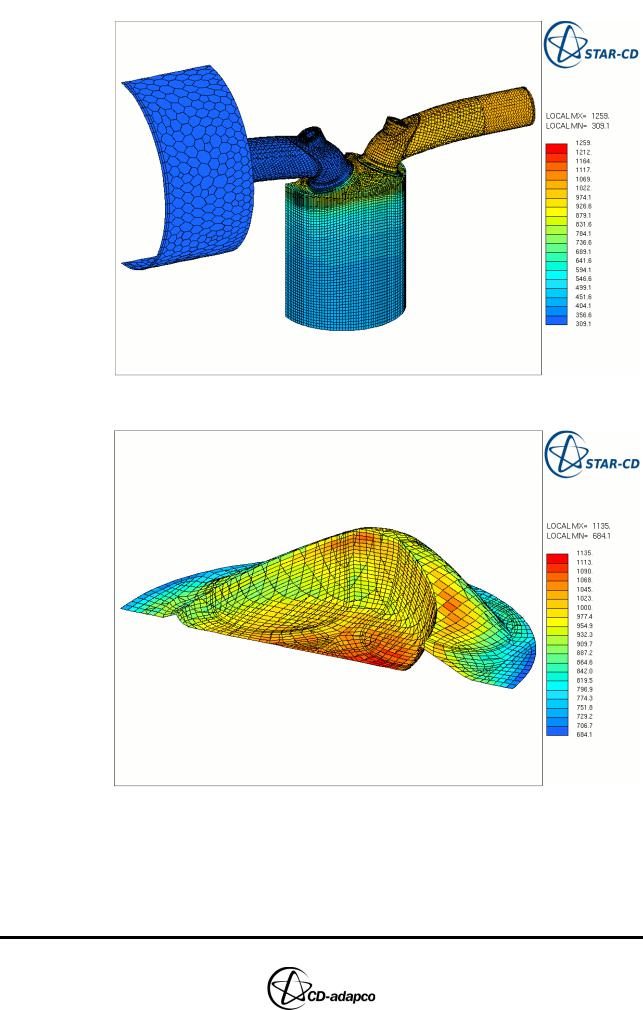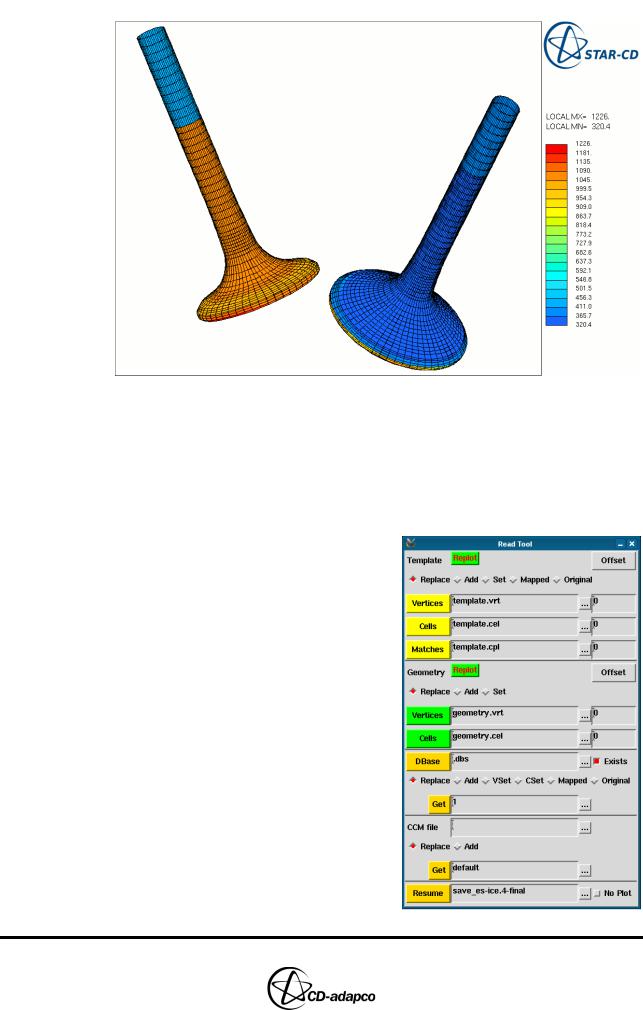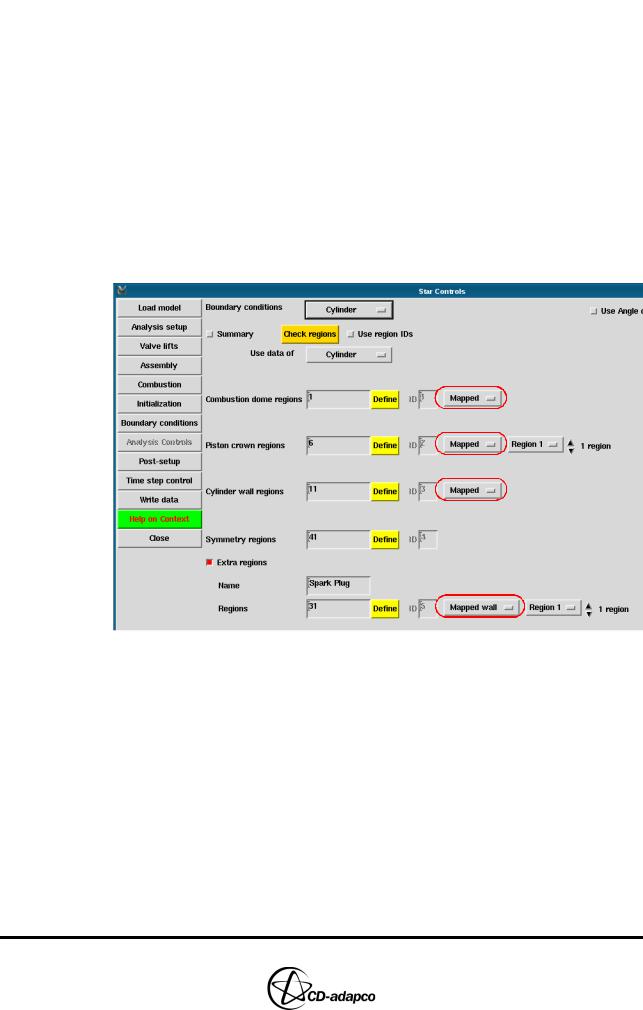
- •TABLE OF CONTENTS
- •Chapter 1 INTRODUCTION
- •The es-ice Environment
- •es-ice Meshing Capabilities
- •Tutorial Structure
- •Trimming Tutorial Overview
- •Required Files
- •Trimming Tutorial files
- •Automatic 2D Tutorial files
- •Wall Temperature Tutorial files
- •Mesh Replacement Tutorial files
- •Multiple Cylinder Tutorial files
- •Closed-Cycle Tutorial files
- •Sector Tutorial files
- •Two-Stroke Tutorial files
- •Mapping Tutorial files
- •ELSA Tutorial files
- •Chapter 2 SURFACE PREPARATION IN STAR-CCM+
- •Importing and Scaling the Geometry
- •Creating Features
- •Defining Surfaces
- •Remeshing and Exporting the Geometry
- •Chapter 3 GEOMETRY IMPORT AND VALVE WORK
- •Importing the Surfaces
- •Modelling the Valves
- •Saving the Model
- •Chapter 4 MESHING WITH THE TRIMMING METHOD
- •Modifying Special Cell Sets in the Geometry
- •Defining Flow Boundaries
- •Creating the 2D Base Template
- •Creating the 3D Template
- •Trimming the 3D Template to the Geometry
- •Improving cell connectivity
- •Assembling the Trimmed Template
- •Running Star Setup
- •Saving the Model
- •Chapter 5 CREATING AND CHECKING THE MESH
- •Chapter 6 STAR SET-UP in es-ice
- •Load Model
- •Analysis Set-up
- •Valve Lifts
- •Assembly
- •Combustion
- •Initialization
- •Cylinder
- •Port 1 and Port 2
- •Boundary Conditions
- •Cylinder
- •Port and Valve 1
- •Port and Valve 2
- •Global settings
- •Post Set-up
- •Cylinder
- •Port 1 and Port 2
- •Global settings
- •Time Step Control
- •Write Data
- •Saving the Model
- •Chapter 7 STAR SET-UP in pro-STAR
- •Using the es-ice Panel
- •Setting Solution and Output Controls
- •File Writing
- •Chapter 8 RUNNING THE STAR SOLVER
- •Running in Serial Mode
- •Running in Parallel Mode
- •Running in Parallel on Multiple Nodes
- •Running in Batch
- •Restarting the Analysis
- •Chapter 9 POST-PROCESSING: GENERAL TECHNIQUES
- •Creating Plots with the es-ice Graph Tool
- •Calculating Apparent Heat Release
- •Plotting an Indicator Diagram
- •Calculating Global Engine Quantities
- •Creating a Velocity Vector Display
- •Creating an Animation of Fuel Concentration
- •Creating an Animation of Temperature Isosurfaces
- •Chapter 10 USING THE AUTOMATIC 2D TEMPLATE
- •Importing the Geometry Surface
- •Defining Special Cell Sets in the Geometry
- •Modelling the Valves
- •Creating the Automatic 2D Template
- •Refining the 2D Template Around the Injector
- •Adding Features to the Automatic 2D Template
- •Using Detailed Automatic 2D Template Parameters
- •Saving the es-ice Model File
- •Chapter 11 MULTIPLE-CYCLE ANALYSIS
- •Setting Up Multiple Cycles in es-ice
- •Setting Up Multiple Cycles in pro-STAR
- •Chapter 12 HEAT TRANSFER ANALYSIS
- •Resuming the es-ice Model File
- •Mapping Wall Temperature
- •Exporting Wall Heat Transfer Data
- •Saving the es-ice Model File
- •Cycle-averaging Wall Heat Transfer Data
- •Post-processing Wall Heat Transfer Data in pro-STAR
- •Plotting average wall boundary temperatures
- •Plotting average heat transfer coefficients
- •Plotting average near-wall gas temperature at Y-plus=100
- •Mapping Heat Transfer Data to an Abaqus Model via STAR-CCM+
- •Chapter 13 MESH REPLACEMENT
- •Preparing the File Structure
- •Rebuilding the Dense Mesh
- •Creating Ahead Files for the Dense Mesh
- •Defining Mesh Replacements
- •Setting Up Mesh Replacement in pro-STAR
- •Setting up the coarse model
- •Setting up the dense model
- •Chapter 14 MULTIPLE CYLINDERS
- •Resuming the es-ice Model File
- •Making, Cutting and Assembling the Template
- •Setting Up Multiple Cylinders
- •Checking the Computational Mesh
- •STAR Set-Up in es-ice
- •Analysis set-up
- •Assembly
- •Combustion
- •Initialization
- •Boundary Conditions
- •Post Setup
- •Time Step Control
- •Write Data
- •Saving the es-ice Model File
- •Importing the Geometry
- •Generating the Closed-Cycle Polyhedral Mesh
- •Assigning shells to geometry cell sets
- •Specifying General, Events and Cylinder parameters
- •Creating a spray-optimised mesh zone
- •Importing a user intermediate surface
- •Checking the spray-optimised zone
- •Creating the closed-cycle polyhedral mesh
- •Running Star Setup
- •Creating and checking the computational mesh
- •Saving the Model File
- •Chapter 16 DIESEL ENGINE: SECTOR MODEL
- •Importing the Bowl Geometry
- •Defining the Bowl Shape
- •Defining the Fuel Injector
- •Creating the 2D Template
- •Creating the Sector Mesh
- •Creating and Checking the Mesh
- •Saving the Model
- •Chapter 17 DIESEL ENGINE: STAR SET-UP IN es-ice and pro-STAR
- •STAR Set-up in es-ice
- •Load model
- •Analysis setup
- •Assembly
- •Combustion
- •Initialization
- •Boundary conditions
- •Post setup
- •Time step control
- •Write data
- •Saving the Model File
- •STAR Set-up in pro-STAR
- •Using the es-ice Panel
- •Selecting Lagrangian and Liquid Film Modelling
- •Setting up the Fuel Injection Model
- •Setting up the Liquid Film Model
- •Setting up Analysis Controls
- •Writing the Geometry and Problem Files and Saving the Model
- •Chapter 18 DIESEL ENGINE: POST-PROCESSING
- •Creating a Scatter Plot
- •Creating a Spray Droplet Animation
- •Chapter 19 TWO-STROKE ENGINES
- •Importing the Geometry
- •Meshing with the Trimming Method
- •Assigning shells to geometry cell sets
- •Creating the 2D template
- •Creating the 3D template
- •Trimming the 3D template to the geometry
- •Assembling the trimmed template
- •Running Star Setup
- •Checking the mesh
- •STAR Set-up in es-ice
- •Analysis setup
- •Assembly
- •Combustion
- •Initialization
- •Boundary conditions
- •Post setup
- •Time step control
- •Write data
- •Saving the es-ice Model File
- •Chapter 20 MESHING WITH THE MAPPING METHOD
- •Creating the Stub Surface in the Geometry
- •Creating the 2D Base Template
- •Creating the 3D Template
- •General Notes About Edges and Splines
- •Creating Edges and Splines Near the Valve Seat
- •Creating the Remaining Edges and Splines
- •Creating Patches
- •The Mapping Process
- •Chapter 21 IMPROVING THE MAPPED MESH QUALITY
- •Creating Plastered Cells
- •Chapter 22 PISTON MODELING
- •Meshing the Piston with the Shape Piston Method
- •Chapter 23 ELSA SPRAY MODELLING
- •Importing the Bowl Geometry
- •Defining the Bowl Shape
- •Setting the Events and Cylinder Parameters
- •Creating the Spray Zone
- •Creating the Sector Mesh
- •STAR Set-up in es-ice
- •Load model
- •Analysis setup
- •Assembly
- •Combustion
- •Initialization
- •Boundary Conditions
- •Time step control
- •Write data
- •Saving the Model File
- •STAR Set-up in pro-STAR
- •Using the es-ice panel
- •Activating the Lagrangian model
- •Defining the ELSA scalars
- •Setting up the Lagrangian droplets
- •Defining boundary regions and boundary conditions
- •Setting up analysis controls
- •Adding extended data for the ELSA model
- •Writing the Geometry and Problem Files and Saving the Model

Chapter 12 |
HEAT TRANSFER ANALYSIS |
Chapter 12 HEAT TRANSFER ANALYSIS
The model at the beginning of this chapter is resumed from file: save_es-ice.4-final
The following tutorial data files are used in this chapter:
MAPPING_WALL_TEMPERATURE/cylinder_htx.dbs
MAPPING_WALL_TEMPERATURE/cylinder_htx.usr
MAPPING_WALL_TEMPERATURE/valves_htx.dbs
MAPPING_WALL_TEMPERATURE/valves_htx.usr
MAPPING_WALL_TEMPERATURE/engine.inp
The model at the end of this chapter is saved to file: save_es-ice.heat_transfer
es-ice can specify a non-uniform temperature boundary condition on a wall region instead of a Fixed or Adiabatic condition. The non-uniform wall temperature data can be obtained from any source, e.g. from a structural analysis or CFD code, or from experimental data.
In addition, you have the option of outputting calculated wall heat transfer data, e.g. wall heat fluxes, near-wall gas temperatures and wall heat transfer coefficients to a file called es-ice_htx.pos. Within es-ice, you can also cycle-average the wall heat transfer data and use them as boundary conditions for a structural analysis or post-processing run.
The steps for mapping non-uniform wall temperatures and post-processing heat transfer data are outlined below:
1.Map wall temperatures in es-ice
2.Export heat transfer data from the STAR solver
3.Cycle-average the heat transfer data obtained from the STAR solver
4.Post-process the heat transfer data in pro-STAR
5.Map the heat transfer data to an Abaqus model via STAR-CCM+
Figure 12-1, Table 12-2 and Table 12-3 show wall temperature data mapped as boundary conditions for various engine components.
Version 4.20 |
12-1 |

HEAT TRANSFER ANALYSIS |
Chapter 12 |
|
|
Figure 12-1 Cylinder and port wall temperature boundary conditions
Figure 12-2 Piston wall temperature boundary conditions
12-2 |
Version 4.20 |

Chapter 12 |
HEAT TRANSFER ANALYSIS |
|
Resuming the es-ice Model File |
|
|
Figure 12-3 Valve wall temperature boundary conditions
Resuming the es-ice Model File
This tutorial starts from an es-ice model file created at the end of Chapter 6. The file contains data for a case study that is ready to be completed in pro-STAR and then run by the STAR solver. However, some of the boundary conditions and post-processing options need to be changed, as required for a heat transfer analysis.
To resume the es-ice model file:
•Ensure that save_es-ice.4-final is in your current working directory and launch es-ice in the usual manner
•In the Select panel, click Read Data
•In the Read Tool, click the ellipsis (...) next to the Resume box and select save_es-ice.4-final from the file browser
Version 4.20 |
12-3 |

HEAT TRANSFER ANALYSIS |
Chapter 12 |
Mapping Wall Temperature |
|
|
|
Mapping Wall Temperature
First, specify that the cylinder boundary regions are to use mapped wall temperature data.
•In the Select panel, click Star Controls
•In the Star Controls panel, open the Boundary conditions view
•Select the Cylinder domain from the drop-down menu at the top of the panel
•Set boundary conditions for the following boundary regions, as shown in Figure 12-4:
•Combustion dome regions: Mapped
•Piston crown regions: Mapped
•Cylinder wall regions: Mapped
•Extra regions > Spark Plug: Mapped Wall
[
Figure 12-4 Star controls panel: Boundary conditions view for the Cylinder
Similarly, specify that the intake port and valve regions are to use mapped wall temperature data.
•Select the Port and Valve 1 domain from the drop-down menu at the top of the panel
•As before, set boundary conditions for the following boundary regions, as shown in Figure 12-5:
•Valve stem regions: Mapped
•Valve face regions: Mapped
•Port wall regions: Mapped
12-4 |
Version 4.20 |

Chapter 12 |
HEAT TRANSFER ANALYSIS |
|
Mapping Wall Temperature |
|
|
Figure 12-5 Star controls panel: Boundary conditions view for Port and Valve 1
•Set the same boundary conditions for Port and Valve 2, as shown in Figure 12-6
Figure 12-6 Star controls panel: Boundary conditions view for Port and Valve 2
In the following steps, specify the files required to map wall temperature data. The valves are mapped separately to avoid confusion when mapping temperatures in the valve seat region.
•Select the Global settings domain from the drop-down menu at the top of the panel, as shown in Figure 12-7
•Under Wall temperature mapping, set Dbase file to cylinder_htx.dbs and
Dbase ID to 1 to select the cylinder and port surfaces
•Set Temperature to cylinder_htx.usr to specify the wall temperature data file
•Check that the Map valves separately toggle button is selected so that you can specify separate files for the valves
•Under Map valves separately, set Dbase file to valves_htx.dbs and Dbase ID
Version 4.20 |
12-5 |
